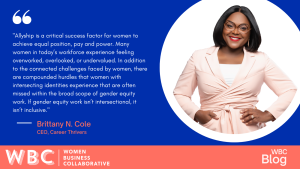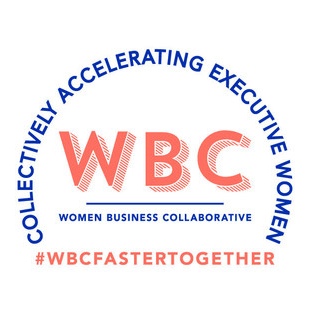
Brittany N. Cole
CEO, Career Thrivers
Allyship is a critical success factor for women to achieve equal position, pay and power. Many women in today’s workforce experience feeling overworked, overlooked, or undervalued. In addition to the connected challenges faced by women, there are compounded hurdles that women with intersecting identities experience that are often missed within the broad scope of gender equity work. If gender equity work isn’t intersectional, it isn’t inclusive. Developing the leadership skill of intersectional allyship raises our awareness and action to contribute to a more inclusive and equitable culture where all women can thrive.
Intersectionality is a term popularized by law professor Dr. Kimberlé Crenshaw. In her 1991 article “Mapping the Margins,” she explained how people who are “both women and people of color” are marginalized by “discourses that are shaped to respond to one [identity] or the other,” rather than both. In short, intersectionality is how multiple identities compound to create unique patterns of inequities. Learn more about The Urgency of Intersectionality in Dr. Crenshaw’s TED talk.
Being an ally of women is not just a noble aspiration, it’s a responsibility for us all. As women, we can close gender gaps across for all women by being more aware of the complexities of our identities and practicing intersectional allyship. Here are four ways we as women can take an intersectional approach to being even better allies of all women.
Acknowledge Your Privilege and Leverage It for Other Women
One of the essential steps in becoming an intersectional ally is acknowledging your areas of privilege. We all have a measure of privilege, and awareness of it is essential for losing gender gaps. While you may experience discrimination and bias for being a woman, other aspects of your identity such as race, sexuality, ability, socioeconomic status, or physical wellbeing confer privilege. It’s essential to educate yourself about different forms of bias and how they intersect to impact different groups of women. As we become more aware of our privilege, we learn how to leverage it to advocate for other women. Consider the last time you advocated for a woman by sharing a referral, making an introduction, selecting a supplier, writing a recommendation, or speaking up – did you do this for a woman with different dimensions of diversity than you? Look for ways to leverage your privilege to support and sponsor other women across different intersections. For example, if you’re a white woman, you can use your platforms to amplify the voices of Black women and other women of color while advocating for policies that work towards addressing systemic racism. Similarly, if you’re a cisgender woman, you can use your privilege to support the rights of trans women and create safe spaces for them.
Uncover and Challenge Your Biases
Challenging your biases requires honest self-reflection and active commitment. We all hold biases, even unintentionally, that can negatively impact how we interact with other women. Some of these biases stem from societal messaging, while others come from our experiences and worldview. By pinpointing and challenging our biases, we become more empathetic, supportive, and respectful of other women, despite what we’ve been taught. This also helps us to challenge systems and structures that enable discrimination against women, ultimately working towards a more equitable society. When you have a thought about another woman, ask yourself, “Why do I think that?” This question will help you uncover the root of our beliefs about others and whether they’re based on experiences or biases.
Amplify the Voices and Issues of Other Women
Intersectional allyship looks like including the voices of diverse women at the decision making table without censoring, editing, or encouraging assimilation. At times our efforts to amplify voices can result in women speaking for other women instead of creating the space for women across diverse intersections to speak for themselves. Amplify the voices of women by sharing the microphone and pulling up a chair for another woman to speak up at the table. From team meetings to townhalls to speakers for events, being an intersectional ally means you seek ways to advocate for the inclusion of women with diverse identities to be seen, heard, and valued.
Advocate for Intersectionality
We can support intersectionality by advocating for policies that recognize the multiple identities of women and creating a more inclusive environment. For example, workplaces must better address the gender pay gap, promote diversity and inclusion, and provide support for women who experience different types of discrimination. Workplaces also need to disaggregate their gender diversity data to assess the impact of DEI priorities on women across various intersections. Additionally, an intersectional approach to talent management can help create tailored programs to advance women of color into leadership roles. By advocating for intersectionality in our communities and workplaces, we help create a society that is more equitable for everyone.
“If you don’t have a lens that’s been trained to look at how various forms of discrimination come together, you’re unlikely to develop a set of policies that will be as inclusive as they need to be.” –Dr. Kimberle’ Crenshaw
Intersectional allyship requires leaders to raise our awareness, compassion, and empathy. As a woman, we all have a responsibility and a privilege to expand as we climb. There is room at the table for all women to be represented. It takes intentional effort to recognize the unique experiences of other women, to challenge our biases, to amplify other voices, and to advocate for intersectionality. It’s through lifelong learning and growth that we become better allies for one another. As women, we have the power to create a more equitable world, and we all have a part to play in helping every woman thrive.



